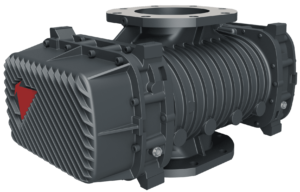 Vacuum blowers are an essential piece of equipment in many industrial settings. They work to enhance airflow through the use of an electric motor, impeller and airfoils. Their purpose is to remove contaminants from the air such as dirt, dust, and move particulate matter. Another application is to cool the process to assist in evaporation as needed.
Vacuum blowers are an essential piece of equipment in many industrial settings. They work to enhance airflow through the use of an electric motor, impeller and airfoils. Their purpose is to remove contaminants from the air such as dirt, dust, and move particulate matter. Another application is to cool the process to assist in evaporation as needed.
Vacuum blowers work at a pressure that is higher than that of a fan and lower than that of a compressor. The main types of vacuum blowers are centrifugal, regenerative, and positive displacement. This article will cover some of the various types of vacuum blowers and how they work.
Positive Displacement Blowers
Also referred to as lobe blowers, positive displacement blowers work by releasing air in a specific direction at a specific time, pressure and velocity. The device has two propellors that counter-rotate. The device allows for the airflow to maintain a constant pressure as the air enters through the chamber of the device and exits through an outlet.
Centrifugal Blowers
The most frequently used type of vacuum blower is the centrifugal blower. This is because this device has the highest ability to continuously block air pollutants and to transfer gas. Using a set of impellers, air flows through the device, and the speed and volume of the airflow can be steadily increased. As more air flows through the device, the blower’s kinetic energy increases.
Regenerative Blowers
These blowers as also referred to as high flow low pressure compressed air blowers. Regenerative blowers work by reducing pressure to create a vacuum. Air enters into the housing of the device where it is compressed, generating pressure. Regenerative blowers can be either single stage or two stage. A two stage blower will create a higher pressure than a single stage.
What are the applications for vacuum blowers?
Vacuum blowers are used in a variety of industries for a number of different applications ranging from ventilation to cooling to dust control. The following are a few applications for which they may be used:
- Air handling – allow for even airflow through a building’s duct systems.
- Dust loading – improving air quality by removing dust and dangerous particles.
- Fume extraction – removing fumes and chemicals from the air.
- Material handling – Using pneumatic pressure to move granular materials through the manufacturing process. (Especially in pharmaceutical, agri-food, and chemical manufacturing).
- Exhaust – particularly in enclosed or small workspaces where fumes and vapours can be an issue, vacuum blowers may be used for exhaust. These blowers must be spark resistant.
- Cooling – these blowers drive out hot air from the work area.
- Blow off – removing dust and particles from manufactured items before painting.
Contact PFS Pumps today
Are you interested in learning more about vacuum blowers and what might be right for your facility? If so, contact PFS Pumps today to speak with a member of our team.
